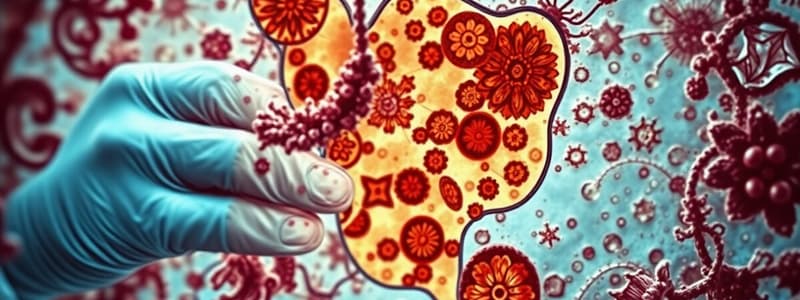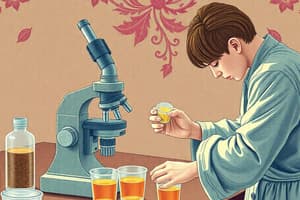Podcast
Questions and Answers
What types of tests indicate that a microscopic examination of urine is needed? (Select all that apply)
What types of tests indicate that a microscopic examination of urine is needed? (Select all that apply)
- Protein (correct)
- Blood (RBCs) (correct)
- Nitrite (Bacteria) (correct)
- Leukocyte esterase (WBCs) (correct)
What is the normal range of red blood cells (RBCs) in urine sediment per high-power field (hpf)?
What is the normal range of red blood cells (RBCs) in urine sediment per high-power field (hpf)?
0 - 3/hpf
In hypersthenuric (concentrated) urine, RBCs appear _____ due to loss of water.
In hypersthenuric (concentrated) urine, RBCs appear _____ due to loss of water.
crenated
Dysmorphic red blood cells can vary in size and have cellular protrusions.
Dysmorphic red blood cells can vary in size and have cellular protrusions.
What is the appearance of squamous epithelial cells in urine sediment?
What is the appearance of squamous epithelial cells in urine sediment?
Which cell type is typically the predominant white blood cell (WBC) found in urine sediment?
Which cell type is typically the predominant white blood cell (WBC) found in urine sediment?
What can be indicated by the presence of more than 2 renal tubular epithelial (RTE) cells per high-power field?
What can be indicated by the presence of more than 2 renal tubular epithelial (RTE) cells per high-power field?
What cellular element is highly indicative of nephrotic syndrome?
What cellular element is highly indicative of nephrotic syndrome?
Trichomonas vaginalis is a common sexually transmitted pathogen and can be found in urine sediment.
Trichomonas vaginalis is a common sexually transmitted pathogen and can be found in urine sediment.
Match the following cells with their characteristics:
Match the following cells with their characteristics:
What is the preferred stain for identifying eosinophils in urine?
What is the preferred stain for identifying eosinophils in urine?
Flashcards are hidden until you start studying
Study Notes
### Microscopic Urine Examination
- Microscopic examination is usually performed if the chemical urinalysis identifies positive results for blood, leukocyte esterase, protein, or nitrite.
- Steps involved in microscopic urine examination:
- Pour urine into a conical tube and cap it.
- Centrifuge the tube at the speed specified in the lab manual.
- Decant the supernatant fluid, leaving only the sediment.
- Apply sediment to a glass slide using a plastic pipette.
- Apply a coverslip to the slide.
- Scan the entire slide for at least 10 low power fields (LPFs) and 10 high power fields (HPFs).
- Microscopic examinations can be performed with or without stains, but stains are more effective in visualizing cellular details.
- Common stains include Sternheimer-Malbin, Sedi-Stain, Sudan III or IV, and Oil Red O.
Microscopy Techniques
- Bright-field microscopy: Used for routine analysis, objects appear dark against a light background.
- Phase contrast microscopy: Used for visualizing elements with low refractive indexes (e.g., hyaline casts, mixed cellular casts, mucus threads, Trichomonas) by adding a phase condenser ring to a bright-field microscope.
- Polarizing microscopy: Uses polarizing filters to identify cholesterol crystals and specific structures in lipids and casts.
Normal Urine Sediment
- Normal urine sediment may contain small amounts of:
- Red blood cells (RBCs)
- White blood cells (WBCs)
- Epithelial cells
- Amorphous urates and phosphates
Red Blood Cells
- RBCs are smooth, non-nucleated, biconcave discs (7µm in diameter).
- Normal range: 0-3 RBCs per high-power field (HPF).
- RBC appearance is affected by urine concentration:
- Hypersthenuric urine (concentrated): RBCs shrink and appear crenated (irregularly shaped).
- Hyposthenuric urine (dilute): RBCs swell and lyse rapidly, releasing hemoglobin and leaving only the cell membrane (Ghost cells).
- Dysmorphic RBCs: Vary in size, have cellular protrusions or are fragmented, suggesting glomerular bleeding, strenuous exercise, or non-glomerular hematuria.
- Identifying RBCs: RBCs can be confused with yeast, oil droplets, and air bubbles. Acetic acid will lyse RBCs, while yeast, oil droplets, and air bubbles will remain intact.
### Clinical Significance of RBCs
- Non-pathologic causes: Menstrual contamination, strenuous exercise, traumatic catheterization.
- Pathologic causes: Damage to the glomerular membrane, pyelonephritis, glomerulonephritis, renal tumors.
- Red/pink, cloudy urine: Intact red cells, hematuria.
- Red, clear urine: Hemoglobin, hemoglobinuria.
White Blood Cells
- Larger than RBCs, smaller than epithelial cells (12µm in diameter).
- Normal range: 0-5 WBCs per HPF.
- Neutrophils: Predominant WBC in urine sediment, contain granules and multilobed nuclei.
- Lyse rapidly in dilute alkaline urine.
- Swell in hypotonic urine, exhibiting Brownian movement of granules, giving a sparkling appearance (glitter cells).
- Stain light blue with Sternheimer-Malbin stain.
- Increased numbers suggest bacterial infection.
- Eosinophils: Rarely seen in urine, increased in drug-induced interstitial nephritis, UTIs, and renal transplant rejection.
- Mononuclear cells: Include lymphocytes, monocytes, macrophages, and histiocytes.
- Lymphocytes are the smallest WBCs, sometimes mistaken for RBCs, increased in renal transplant rejection.
### Clinical Significance of WBCs
- Increased leukocytes in urine (pyuria) indicate inflammation or infection:
- Bacterial infections: Pyelonephritis, cystitis, prostatitis, urethritis.
- Non-bacterial disorders: Glomerulonephritis, lupus erythematosus, interstitial nephritis, tumors.
- >50 WBCs per HPF strongly suggests acute inflammation.
- Clumps of WBCs suggest a kidney origin, often accompanied by WBC casts and WBC/epithelial casts, indicating pyelonephritis.
Epithelial Cells
- Small amounts are normal, representing the shedding of old cells.
- Classified based on their origin in the genitourinary system:
- Squamous epithelial cells: Largest cells, abundant, irregular cytoplasm, prominent nucleus, originate from the lining of the female urethra and vagina, and the lower portion of the male urethra. Large numbers may indicate non-midstream urine collection.
- Transitional epithelial cells: Line the renal pelvis, calyces, ureters, bladder, and upper male urethra. Smaller than squamous cells, centrally located nucleus.
- Renal tubular epithelial cells (RTEs): From different parts of the renal tubules, varying in size and shape. More than 2 RTEs per HPF indicates tubular injury.
### Clinical Significance of Epithelial Cells
- Squamous epithelial cells: Usually have no pathologic significance, but clue cells (squamous cells covered with Gardnerella vaginalis coccobacillus) indicate a vaginal infection.
- Transitional epithelial cells: Increased numbers suggest inflammation or infection of the genitourinary tract. Cells containing vacuoles or irregular nuclei could indicate malignancy or viral infection.
- RTEs: The most significant epithelial cells, indicating renal tubular necrosis caused by heavy metal exposure, drug toxicity, viral infections, pyelonephritis, malignant infiltrations, or salicylate poisoning.
### Oval Fat Bodies
- Fat found as free droplets or within disintegrating cells.
- Oval fat bodies: RTE cells containing lipids.
- Confirmation:
- Sudan III or Oil Red O stain: Triglycerides and neutral fats will stain orange.
- Polarized light: Cholesterol exhibits a Maltese cross formation.
- Found in patients with nephrotic syndrome, severe tubular necrosis, diabetes mellitus, and trauma.
Bacteria
- Urine should not contain bacteria.
- Few bacteria may be present from contamination during collection, with no clinical significance.
- If a UTI is suspected, bacteria should be accompanied by WBCs.
- Enterobacteriaceae (gram-negative rods) are most associated with UTIs.
- False-negative nitrite test for bacteria:
- High bacterial count resulting in nitrite reduction to nitrogen.
- Bacteria lacking the enzyme to reduce nitrate to nitrite.
- Insufficient bladder incubation time for nitrite reduction.
- Low nitrate intake from diet.
- Antibiotic use.
Yeast
- Small, refractile oval structures, may or may not be budding.
- Can be mistaken for RBCs.
- Often found in diabetics due to acidic urine containing glucose.
- Primarily Candida albicans.
- Also seen in immunocompromised patients.
Spermatozoa
- Oval, tapered heads with long tails, rarely motile in urine due to toxicity.
- Rarely clinically significant except in cases of male infertility.
- Retrograde ejaculation: Sperm is expelled into the bladder instead of the urethra.
- Laboratories may or may not report spermatozoa due to lack of clinical significance and potential legal consequences.
- Large amounts of semen can cause a positive protein result on the reagent strip.
Mucus
- Thread-like structures with a low refractive index.
- Uromodulin (glycoprotein) is the major constituent, excreted by RTE cells of the distal convoluted tubules and upper collecting ducts.
- Can be confused with hyaline casts.
- Found more frequently in specimens from females.
Parasites
- Trichomonas vaginalis: Most frequently seen parasite, pear-shaped with an undulating membrane, rapid darting movement when motile. Only report if motility is present.
- Schistosoma haematobium: Bladder parasite, ova may be found in urine, not often seen in North America.
- Enterobius vermicularis: Intestinal parasite, pinworm ova may be found in urine following fecal contamination.
Artifacts
- Starch granules: Highly refractive spheres with a dimpled center, contamination from powdered gloves.
- Hair and fibers: Long and refractile with dark edges, contamination from clothing and diapers.
Studying That Suits You
Use AI to generate personalized quizzes and flashcards to suit your learning preferences.




